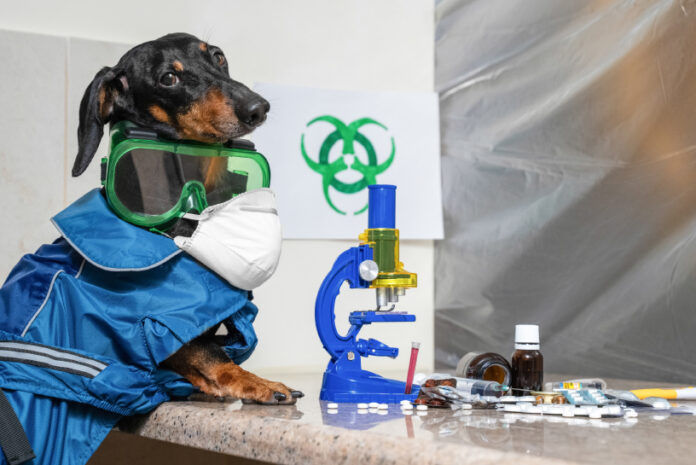By Dr Silvia Zayadin, Veterinarian
Last month, I wrote about how your veterinarian will recommend running blood tests for your furry friend, either as part of a routine checkup or when your pet is not feeling well.
Today, I discuss blood chemistry. This is another common group of blood tests we use to measure certain components of the blood.
Your pet’s wellbeing
These tests can provide information and clues regarding the wellbeing of our furry friends. When your pet experiences disease symptoms, these tests aid us in knowing the cause of the disease therefore providing the best treatment options.
These tests can be done even if your pet is not showing any symptoms of diseases and as a part of a comprehensive wellness examination. They are also important before your pet undergoes anesthesia to be able to design the safest anesthetic protocol with lowest risks possible.
Senior pets
It is recommended to do a blood chemistry test for your pet once a year. For senior pets (7 years old and above) this test is recommended twice a year for early detection of potential age-related diseases and conditions even before any symptoms develop. This way, any discovered diseases will be more effectively treated or managed.
What do those abbreviations mean?
BUN (blood urea nitrogen): BUN is filtered and excreted by the kidneys. When it is high, this indicates the inadequate function of the kidneys or presence of high amounts of protein in the body (usually from the diet). Situations of dehydration, shock and some heart and urinary tract diseases can also contribute to its increase
Crea (creatinine): This is another waste material produced by muscle metabolism. It is cleared from the blood by the kidneys, thus it is a very important indicator for kidney function. When BUN is elevated, the creatinine is used to differentiate between kidney and non-kidney diseases
PHOSPH (phosphorus): This is a component in bone formation. It is regulated by the kidneys and any elevation in its values signals a problem in them. When it is low, it means that the body is losing a lot of phosphorus and the most common source is through the digestive system
ALP (Alkaline phosphatase): This is an enzyme produced by the liver. In liver and some metabolic or hormonal diseases like Cushing’s, ALP it is elevated. It can also be high in young animals but in this case is totally normal
ALT (Alanine aminotranferase): When liver cells are damaged because of a disease, this enzyme leaks from cells to the blood stream and causes elevated readings. It is considered a liver specific enzyme
AST (Aspatate aminotranferase): An enzyme that is also found in the liver, muscles and heart, thus its elevation indicates damage in any of these organs
GGT (gamma glutamyl transferase): Another liver enzyme that can indicate liver disease if found to be high in your pet
Bilirubin: When the bilirubin values are high, it is due to red blood cells breaking down. Some types of anaemia (hemolytic anaemia) are an example. Readings also indicate how the bile ducts and liver are functioning
Amylase: An enzyme produced by the pancreas and is important in the digestion of fat in the body. It can be elevated due to many causes, but mainly because of pancreatic disease. Other causes are certain medications, gastrointestinal or kidney diseases
Lipase: Another enzyme produced by the pancreas is lipase. It is important in the digestion of fat and protein. Elevation in its values is mainly due to pancreatic disease
Glucose: An essential type of sugar that is the main source of energy for some organs like the brain. It plays an important role in diabetes and is used as a diagnostic indicator for this disease when it is elevated. On the other hand, low values are related to liver and metabolic diseases
Total protein: Two proteins (albumin and globulin) form this indicator. Globulin is part of the immune system and is elevated in more chronic (long term) inflammations. It is low when there are gut diseases, bleeding and some immune problems
Albumin is elevated when the body is dehydrated or bleeding. When it is low, this indicates kidney, gut and liver abnormalities
Calcium inflammation of the pancreas: An important ion that has many functions in the body such as bone formation. It is high in some cancers, metabolic or kidney diseases
Electrolytes (Sodium, Potassium, Cholride): Some diseases and symptoms can affect the values of these electrolytes such as vomiting, diarrhea and dehydration. They can indicate kidney diseases if their ratio is abnormal and are not properly regulated
Cholesterol and triglycerides: Certain liver intestinal diseases contribute to the low blood serum levels of cholesterol
CK (creatinine kinase): A muscle enzyme; its elevation indicates severe muscle damage
So, with the conclusion of this series on the importance of regular blood work for your furry friends, you now understand the significance of blood chemistry and hormonal tests
Did you check your pet’s blood chemistry recently?
Schedule an appointment with your veterinarian as soon as possible and get your pet checked. Prevention is key!
You can contact Dr Silvia Zayadin at [email protected]






